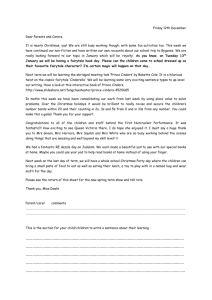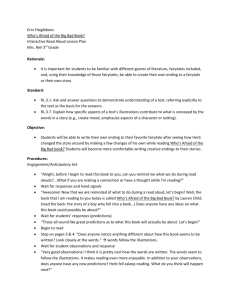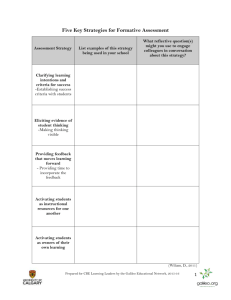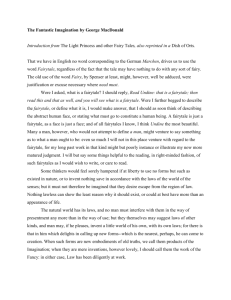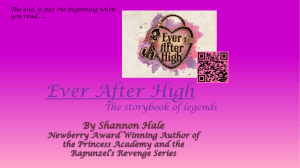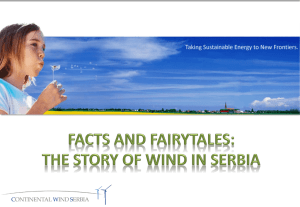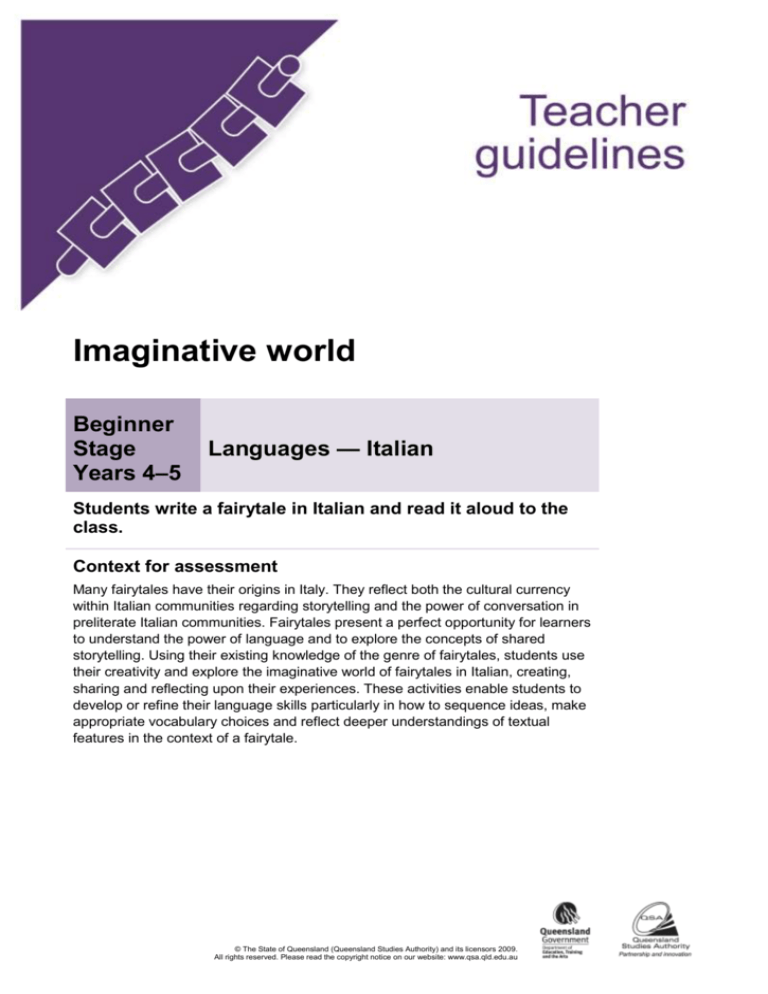
Imaginative world
Beginner
Stage
Years 4–5
Languages — Italian
Students write a fairytale in Italian and read it aloud to the
class.
Context for assessment
Many fairytales have their origins in Italy. They reflect both the cultural currency
within Italian communities regarding storytelling and the power of conversation in
preliterate Italian communities. Fairytales present a perfect opportunity for learners
to understand the power of language and to explore the concepts of shared
storytelling. Using their existing knowledge of the genre of fairytales, students use
their creativity and explore the imaginative world of fairytales in Italian, creating,
sharing and reflecting upon their experiences. These activities enable students to
develop or refine their language skills particularly in how to sequence ideas, make
appropriate vocabulary choices and reflect deeper understandings of textual
features in the context of a fairytale.
© The State of Queensland (Queensland Studies Authority) and its licensors 2009.
All rights reserved. Please read the copyright notice on our website: www.qsa.qld.edu.au
Teacher guidelines
This assessment gathers evidence of learning for the following Essential Learnings:
Languages
Essential Learnings by the end of Beginner Stage
Ways of working
Knowledge and understanding
Students are able to:
Comprehending and composing in the target
language
identify the purpose or main
topic in simple spoken and
written texts, using visual and
verbal language
identify and use non-verbal
communication strategies in
familiar contexts
construct simple spoken and
written texts in familiar contexts.
Comprehending and composing skills are used to
understand language input, to convey information
and to express ideas in response to needs and
interests.
Verbal language and non-verbal language are used
in simple, routine exchanges to negotiate meaning.
Language forms, functions, grammar and vocabulary
are combined with process skills and strategies to
make meaning.
Listening for and locating key words and phrases,
and using memorised material helps to make
meaning.
Manipulating known language helps to make
meaning in different contexts.
Assessable elements
Knowledge and understanding
Composing texts
Source: Queensland Studies Authority 2007, Languages Essential Learnings by the end of Beginner stage, QSA, Brisbane.
2
Beginner Stage Years 4–5 Languages — Italian: Imaginative World
Listed here are suggested learning experiences for students before implementing this
assessment.
Share the experience of reading a selection of fairytales in English. Bigbooks are ideal for this
introduction, e.g. The Paper Bag Princess, The Three Little Pigs and Little Red Riding Hood.
Students join in chorus reading and sequence illustrations while listening to the story.
Identify and appreciate the purpose of fairytales.
Share the experience of reading a selection of fairytales in Italian. These may be simplified
translated versions of well-known or traditional Italian stories, e.g. Pinocchio, Momotaro, Le
Reynard.
Notice and compare aspects of students’ own culture and of the target culture as noted in the
fairytales.
Reflect on and evaluate the layout and presentation of these texts and consider the format
their own final presentation will take. Discuss options, including electronic/PowerPoint format,
which may be presented with their own voice as the storyteller.
Identify that the introductory sentence, “Once upon at time …”, is the contextual cue that
signals a fairytale. At this stage, by refering to a traditional fairytale in a particular target
language, this same introduction can be learned in that language, e.g. “C’era una volta …”
(Italian).
Identify and analyse the components of a complete fairytale — beginning, middle, ending. To
facilitate planning, teachers can provide English examples of these three components in a nonsequential order so text has to be manipulated to create a logical fairytale (see Appendix A:
Sequencing fairytales). From their English sessions, students should already understand the
contents to include in the beginning (when, where and who), the middle (recounting character
interactions) and the end (bringing the tale to either a happy or a sad closure, or leaving the
reader in suspense).
Participate in the process of selecting characters, setting and story-line and present ideas to
the class. These can be added to an Italian thematic word bank. This word bank could include
a range of possible characters, suggested list of personal names for males and females in
Italian, a selection of descriptive words, phrases indicating suggested settings or locations and
a variety of verbs to describe character movement or activity (see Appendix B: Cloze
exercise).
Participate in constructing a whole class fairytale using Italian word clusters. A simple fairytale
can be created by selecting appropriate words from the list to complete the accompanying
cloze text (see Appendix B: Cloze exercise). This activity could be completed with whole class
participation on a whiteboard. This would enable the text to be easily manipulated by either
students or the teacher, using the same vocabulary to present many different combinations of
characters, settings and events.
Infer the meanings of Italian words by noticing and comparing Italian to English, and matching
teacher-prepared illustrations to the vocabulary. Although most of the vocabulary will be new to
3
Teacher guidelines
the students, they should enjoy the challenge of extending their Italian vocabulary because of
the simplicity of the task and the limited vocabulary proposed.
Listen as the teacher models the correct pronunciation of the text with accurate intonation,
stress, fluency and expression. Students can firstly repeat the reading of the created fairytale in
groups, then individuals can be asked to volunteer for the role of the one of the characters. A
student can also be selected as narrator.
Construct and illustrate a simple fairytale outline on a storyboard showing the characters and
the locations where the story will unfold. Prepare a sequence of events and link them to where
these will take place.
Reflect on and evaluate the suitability of language and illustrations used in the storyboard.
Teacher resources
For information supporting the implementation of this assessment, please refer to the Years 4 to 10
LOTE Curriculum materials on CD-ROM (Upper Primary, Sourcebook modules — Personal and
Community Life: Community Celebrations). To access these modules from the QSA website
www.qsa.qld.edu.au select > Learning P-12 > Years 1-9 > Essential Learnings > Past syllabuses.
Appendix A
Sequencing a fairytale
Appendix B
Cloze exercise
Implementation
Consider these points when implementing the assessment:
To create their own fairytale, students may use the ideas suggested in the lead-up to the
assessment. They may manipulate these suggestions or choose other characters, settings and
events. The teacher will facilitate writing and assist with dictionary use and Italian sentence
structures that may be an extension of the ones proposed for the assessment.
Students finalise their presentation, refining illustrations and layout, and proofreading their own
text. Students may select a partner with whom to share their fairytale. This student can assist
with proofreading by making suggestions. Students practise reading their fairytale aloud to their
partner.
Students read their fairytale in Italian to the whole class. It may be appropriate to share their
creativity by repeating their presentations to students in lower classes. Students’ fairytales can
then be placed on display in the classroom or in a designated section of the library for other
students and members of the wider school community to enjoy.
4
Beginner Stage Years 4–5 Languages — Italian: Imaginative World
Sample implementation plan
This table shows one way that this assessment can be implemented. It is a guide only — you may
choose to use all, part, or none of the table. You may customise the table to suit your students and
their school environment.
Suggested time
Student activity
Teacher role
Section 1. Writing your own fairytale in Italian
2 hours
Use new knowledge of the
Italian language and fairytale
structure to plan a fairytale.
Complete first draft of the
fairytale. Use Appendix C:
Drafting a fairytale and the
vocabulary table from
Appendix B: Cloze activity to
help you.
Read the draft edit and refine.
Decide on written presentation
mode and complete.
Explain assessment and answer
questions.
Monitor, provide feedback, assist as
required.
Advise on accuracy of Italian
sentence structures.
Listen to students’ intended
meanings and suggest appropriate
alternatives if applicable.
Assist with proofreading.
Express opinions, offer suggestions
about formats of presentations.
Explain to students that any artwork
or illustrations are not assessed.
They are assessed on their written
text in Italian.
Section 2. Reading your fairytale in Italian to an audience
1 hour
Practise reading story aloud.
Explain assessment and answer
questions.
Provide feedback on delivery.
Assist with pronunciation for oral
presentation.
1 hour
Read fairytale to the class.
Assist as required.
Resources for the assessment
Appendix A
Sequencing a fairytale
Appendix B
Cloze exercise
Appendix C
Drafting a fairytale
5
Teacher guidelines
During the learning process, you and your students should have developed a shared
understanding of the curriculum expectations identified as part of the planning process.
After students have completed the assessment, identify, gather and interpret the information
provided in student responses. Use only the evidence in student responses to make your judgment
about the quality of the student learning. Refer to the following documents to assist you in making
standards-referenced judgments:
Guide to making judgments
Indicative A response
Sample responses (where available).
For further information, refer to the resource Using a Guide to making judgments,
available in the Resources section of the Assessment Bank website.
Evaluate the information gathered from the assessment to inform teaching and learning strategies.
Involve students in the feedback process. Give students opportunities to ask follow-up questions
and share their learning observations or experiences.
Focus feedback on the student’s personal progress. Emphasise continuous progress relative to
their previous achievement and to the learning expectations — avoid comparing a student with
their classmates.
For further information, refer to the resource Using feedback, available in the
Resources section of the Assessment Bank website.
6
Appendix A
Sequencing a fairytale
Rearrange the following texts in a logical sequence by numbering each paragraph.
Pinocchio told many lies and his nose became longer and longer. One day instead of going
to school he went to the theatre. There he met a cruel fire-eater. Pinocchio was very sad
and wanted to return to Geppetto.
With the help of a magic fairy, Pinocchio changed his ways and became a real boy and
lived happily with Geppetto.
Once upon a time many, many, many years ago in a small village in Italy, there lived an old
wood carver. His name was Geppetto. He wanted to carve a puppet out of a piece of wood.
As he carved he heard a voice saying, “Ouch, you are hurting me.” The wood was animated
so Geppetto adopted this live puppet and named him Pinocchio.
Appendix B
Cloze exercise
C’era una volta
Un marziano
verde
nella foresta
mangiava
Un astronauta
marrone
nello spazio
dormiva
Un mostro
feroce
nella giungla
cantava
Un dragone
gentile
nel mare
giocava
Un dinosauro
forte
nel fiume
parlava
Un leone
contento/a
nella caverna
piangeva
Un re
grande
sulla luna
rideva
Una regina
triste
nel bosco
nuotava
Una strega
arrabbiato/a
sul pianeta
ballava
Una principessa
crudele
alla spiaggia
correva
Un gigante
selvaggio/a
montagna
scappava
Write a story choosing appropriate words from the list above to complete the sentences below.
Sentences
C’era una volta .................................................................................................................................
Era molto .........................................................................................................................................
Si chiamava .....................................................................................................................................
Abitava .............................................................................................................................................
Un giorno ando` ...............................................................................................................................
Vide (he / she saw), incontro` (he/ she met), trovo` (he / she found) ................................................
Era molto ............................. e .......................................................................................................
“ ............................................ ”, disse (he /she said). “ .................................................................... ”.
(Vieni con me — come with me; non piangere — don’t cry; giochiamo insieme — let’s play together;
Io ti amo — I love you; io ti aiuto — I’ll help you; io ti porto a casa — I’ll take you home.)
E cosi` vissero felici insieme per sempre. (And so they lived together happily ever after.)
Appendix C
Drafting a fairytale
Draft your own fairytale using the vocabulary given below and in the Cloze exercise.
Beginning
C’era una volta…(Once upon a time)
Tanti e tanti anni fa…(Many, many years ago)
Molto tempo fa…(A long time ago)
C’era…(There was)
C’erano…(There were)
Middle
ando`(went), fece (did, made), allora (so, then), che era (who was), diede (he/she gave),
cosi`(so), che aveva (who/ which had), che andava (who/which went), perche’ (because), che
abitava (who lived), invece (instead), che si chiamava (whose name was )
Ending
… e visse felice e contento. (… and he lived happily ever after.)
… e visse felice e contenta. (… and she lived happily ever after.)
… e vissero felici e contenti. (… and they lived happily ever after.)
… cosi` fini` che … (… and so in the end …)
Tutti erano felici e contenti insieme. (They were all happy together.)
1. Select the characters.
2. Select some descriptive words to describe the characters.
3. Decide on a setting for the events.
4. Plan action/interaction by using some of the verbs on the suggested list.
5. Select a title for your fairytale.

